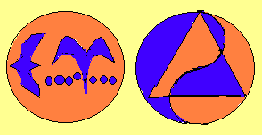.SYSTEMS GENETICS.
Structurity: Pan-Evolution Theory
The Vascular and Neuro-endocrine Pattern in Morphogenesis
B. J. Zeng
ABSTRACTS:
Organism is morphogenetic system which components complete each other to structure stratification,
interflow bounds growth by functional couple, coordinative organization transform as holographic symmetry.
Biosystems are self-renew, self-duplication, self-regulation, and self-adaption information control
systems which are dynamically regulated by the genomic organizing pattern, developmental function and
evolutional mutagenesis.
During the embryo morphogenesis, the pattern of body construction involves a series of genes expression
in primordium modules developing and cell lineages differentiation in organogenesis. We draw attention
to the cross talking and cells communication among neuron, endocrine and immune systems, and the vascular
developing patterns. In Traditional Chinese Medicine (TCM), the main and collateral channels are
the functional integrative systems of neuro-endocrine, immune and circulatory regulation. The
psychosomatic regulation and genetic pattern play bidirectional control roles on pathogenesis
of human organism. The organogenesis pattern involve a series of signals which regulate the cell division,
differentiation and the mapping of cells lineages. The organizing of cells mapping is regulated by
the program expression of signal transmission patterns. The cell phenotypes developing occur
as the result of a complex spatiotemporal genes expression among numerous factors controlling.
The cardiovascular diseases most like lost control of cell cycle, rhythmical regulation and gene expression
involved in the metabolism, vascular function and cell differentiation, proliferation. We were
investigating the mechanism that control the pathogenesis and morphogenesis patterns of vascular
systems, and the pharmacognacy effects on the metabolism involved in memory function. We characterized
novel relationships of the main, collateral channels among organs (TCM), obtained successfully
the drug resistant cellular mutants by multiple steps mutagenesis, and developed a
novel pharmacy
for improvement of memory function and the synthetic therapy of the complex cardiovascular
diseases.
The homeostasis or dynamics of molecules synthesis between degradation, cells
proliferation between apoptosis which involve the replication, fragmentation, recombination and expression of gene. In the
natural evolution, cells were self-organized in genomic patterns. The genomic stratification is the
self-organization of gene families, gene groups and gene chains. The pattern (system - structure) genetics
includes the follow three main aspects.
I ). Structure integration - coordinative organization of genes in genomic stratum. The
independent organism phenotype is controlled by synergic expression of gene group (multigenes), and
this phenotype forms a functional or morphogenesis unit (module). Each specie has it's unique
structure of genomic organizing pattern among chromosomes by the constructing of genomic stability
during evolution of genetic co-adaptation. From elements of gene, operon, gene group to chromosome,
they are the multiple levels of structural patterns of genome. The biochemical metabolism systems
include the essential systems in original cells, adaptation systems in cell species, and program
induced expression systems in tissue cells such as the neuron, endocrine, immune and vascular cells etc.
II ). Functional adaptation - program expression of organism phenotypes: a). structure
duplication (amplify) of cell genome, b). tissue-specific expression of genes. The sequential
expression of genes chain in genomic program involves the interaction among locus of genes in
chromosome, molecules network within cell and signal communication between cells. The patterns
of neuron, endocrine, immune and vascular cell types which develop from ectoderm, endoderm and
mesoderm of embryo. These cells have specific receptors, signal molecules for cell communication
at bidirectional.
In mammalian embryo, the notochord which developed from grey crescent of organizer, the double
gradient of head and trunk signals, the stem cell producing center and the neuro-endocine, immune
system play roles in the control of morphogenesis at multiple levels. The connection
of neural networks
occur as the result of cell recognition and specific protein biosynthesis. The stimulating pattern of
learning experience strengthen specific connections among neurons. The cell phenotypes expression
and mapping of cells fate determination in organogenesis involves a series of genes spatially and
temporally expression by genomic program. The stable rhythm patterns of secretary molecules regulate
gene expression in bio-molecules synthesis, degradation and cells differentiation,
proliferation and apoptosis.
III ). Stratified (Mutation) construction - self-organization of genomes in evolution:
a). recombinant at same level of structure- the homologous recombination, genes rearrangement in
the genetic crossover, transpose of mobile elements; b). multiple stratum structure of gene groups
at different levels; c). mutation in gene families: gene family origin from the series of mutations
in gene duplication. The evolution of biological species origin from the stratum constructing of
genomes. The main evolution pathway of organisms is the evolution from prokaryocyte, eukaryocyte to
multiple cells organism.
The recombination (genetic crossover, mobile elements transpose), transgenesis and amplification
of genes are the dynamic procedures of genome. The artificial evolution includes the engineering
evolution of biosystems by genetic and bionic engineering. The transgenesis in genome has be allowed to
used for manufacture products (bioreactor, xenotransplantation), genetic improvement (organism
breeding, gene therapy) and research methods (disease models, gene regulation). However, the
transgenes have deleterious effects, transmission un-stability of genome. The isolation of embryonic stem
(ES) cells, primordial germ cells (PGC), formation of chimeras from reimplanting embryo by gene
targeted ES cells injection are important tools for the study of cell program differentiation,
pattern of morphogenesis and pathogenesis of diseases.
The pattern genetics is the science to study the complex pattern relationship between
phenotype and
genotype, the genes expression network of genomic program, the bio-logic principles of biosystems and
the organizing patterns of genomes. The genetic program controls the genotype developing into
phenotype,
genes expression into functional proteins, modules constructing to the pattern of in morphogenesis.
The morphogenesis of biosystems which include molecules, cell types, organs and organisms, involves a series
of metabolism, molecular signals and genes regulated expression in the cell division, differentiation and
patterning of vascular, neuro-endocrine and immune systems.

Please cite as:
B. J. Zeng, "Structurity: Pan-Evolution Theory" (Biosystem Medicine - Psychosomatics Thesis, 1986-1993, 1994),
Structurity Bulletin 1999.
Structurity Bulletin


